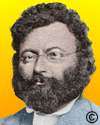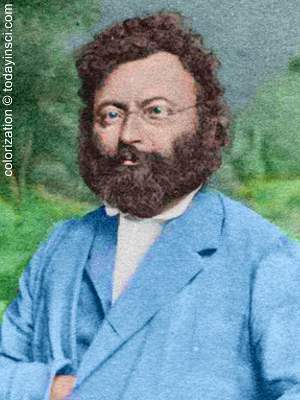 (source)
(source)
|
Amanz Gressly
(17 Jul 1814 - 13 Apr 1865)
Swiss geologist and paleontologist who coined the term facies to describe lateral regional variations in the character and fossil content of rock strata resulting from environmental differences at the time of original deposition.
|
Amanz Grassly - Biography
from History of Geology and Palæontology to the End of the Nineteenth Century (1901)

[p.502] Amanz Gressly, born 1814 in a remote valley near Laufon, in the Jura mountains (Canton Solothurn), was intended for the Church, and studied in Solothurn, Lucerne, Freiburg, and Strasburg. Stimulated by his social intercourse with Voltz, Thirria, Thurmann, and Agassiz, he devoted himself exclusively to geology, and especially to the research of the Jura mountains. From 1840 to 1850 he geologised in the Solothurn Jura region; he supplied himself with means by the occasional opportunities of delivering expert opinion, drawing up technical estimates, etc. In 1859 he was sent by his patron Desor to Cette, where he studied the mode of life of marine organisms. In 1861 he took part in the Berna Expedition to the North Cape and Iceland; he died in 1865
[p.500] … In two memoirs, published 1832 and 1836, [Jules] Thurmann gave an admirable exposition of the stratigraphy of the Bernese Jura. … [He distinguished a number of] sub-divisions in the Terrain Jurassique. …
[p.502] While it was Thurmann who provided the clue to the stratigraphy and tectonic structure of the Bernese Jura mountains, to Gressly belongs the credit of having for the first time elucidated the lithological and palæontological variations displayed in adjacent localities by deposits of the same geological age. Gressly was the founder of the teaching regarding rock facies, which afterwards played such an important part in the unravelling of Alpine stratigraphy.
In his investigation of the Solothurn Jura, Gressly did not confine himself to the determination of the chronological succession of the Jurassic sub-divisions, but traced the horizontal extension of the different members. He soon became convinced that each particular petrographical development [p.503] of facies of a geological horizon was characterised by a particular kind of fauna, and that certain genera and species, however frequently they might occur in some lithological deposits, were entirely excluded from rock-deposits of the same age, but with a different lithological constitution. Gressly described in great detail the various forms of rock facies which occur in the Solothurn Jura (mud facies, coral facies, sponge facies; pelagic, sub-pelagic, littoral facies, etc.), named the fossil types which were characteristic of each, and judging both from the mineral constitution of the rocks and the fossil organisms contained in them, he drew conclusions regarding the mode of origin of the respective rock-formations.
The differences between littoral deposits, shallow-water and deep-sea deposits were distinguished, and also the variations exhibited by deposits accumulated in the open ocean, or in partially enclosed basins. Examples were likewise given of transitional or passage beds in areas connecting any two characteristic facies-developments. On the whole, Gressly found that the facies variations in the Solothurn Jura were insignificant in the Triassic, Liassic, and older Oolite deposits, but were extremely important in the Middle and Upper divisions of the Oolitic series. (Observations géologiques sur le Jura Soleurois, [1] 1838-40-41.)
By a remarkable coincidence, a French geologist arrived theoretically at views closely resembling those demonstrated by Gressly in the field. Constant Prévost, in 1838, contributed an article to the Bulletin of the French Geological Society, which had special reference to a previous memoir by Prestwich. Prévost explained how in each geological epoch there must be contemporaneous deposits of pelagic, littoral, fluvio-marine, fresh-water, and terrestrial origin, replacing one another locally. Hence the mere lithological character of a rock-deposit could never determine its geological age. Prévost also elucidated the correlation of the faunal types with the various kinds of deposit. Calcareous deposits would, he said, always contain other forms of organic life than arenaceous or argillaceous deposits; on the other hand, deposits of the same lithological character, although of different geological age, might contain very similar fossil types. As an example of the varying constitution of contemporaneous deposits Prévost cited the coarse limestone, the siliceous limestone, and the gypsum of the Paris basin; while he illustrated the occurrence [p.504] of similar fossil remains in deposits of different geological age but the same lithological character, by referring to the lignite formations below and above the coarse limestone of the Paris basin and in the Isle of Wight.
Gressly was so strongly impressed with the variability of rocks considered in horizontal succession that he discountenanced the prevailing endeavour to identify in all the other European areas the same palæontological and lithological sequence as had been established for England. In his opinion this fallacious method was preventing the foreign geologists from arriving at a true conception of the characteristics of the Jurassic succession in their own countries.
[1. In Sand: The Never-Ending Story (2009), 179, Michael Welland describes Gressly’s legacy, represented by his single 1838 publication, as being “an insightful and widely influential one.” Gressly articulated the simple idea, as expressed by Welland, that “if ancient sediments can be read correctly, then we should be able to make paleogeographical maps of the Earth’s past, showing lagoons, tidal flats, beaches, dunes, and barrier islands, in the same way we make maps of the geography of today.” ]
- 17 Jul - short biography, births, deaths and events on date of Gressly's birth.
- Large colorized picture of Amanz Gressly - upper body (500 x 650 px).




